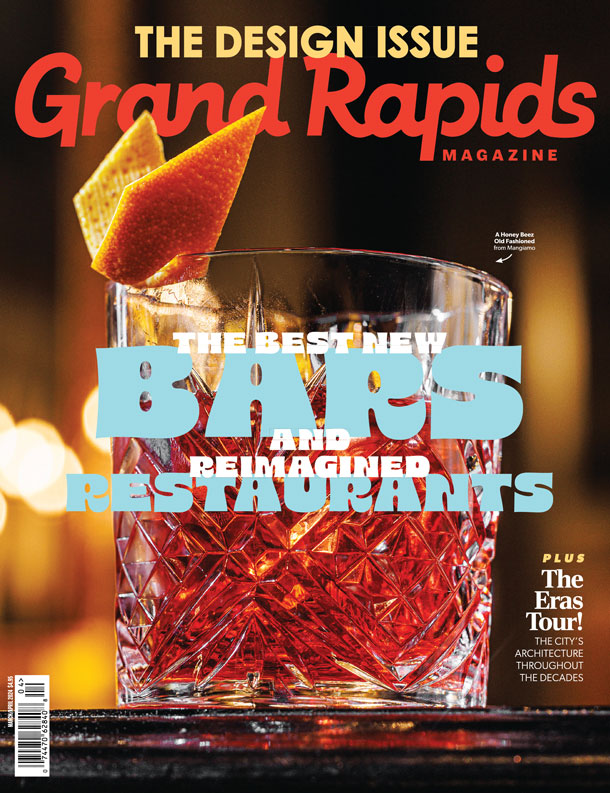Change is in the wind in the Third Ward of Grand Rapids.
Preston Sain released the renderings to a major $15 million development at the corner of Eastern Avenue and Burton Street. The 35,000-square-foot project includes 11,000 square feet of commercial space and 34 apartment units.
The Eastern & Burton Village District will be the flagship development of Sain’s Black Wallstreet Grand Rapids, a mission to develop eight business districts within the Third Ward over a 16-year period — and a $100 million capital commitment to the city.
“Black Wallstreet development is a breath of fresh air, on top of great relationships, it’s a solution, a project and a vision,” Sain told the Magazine. “It’s an alternative to gentrification, because if we don’t come up with an agenda, someone else will.”
Behind Sain’s development — which is a partnership with nine other Grand Rapidians — is a lot of symbolic numbers. Sain is celebrating his birthday on Nov. 14, which happens to be the same date historic Black Wall Street figure Booker T. Washington died in 1915.
The goal of Black Wallstreet Grand Rapids is to pull the entire Grand Rapids community up from a disastrous 2015 Forbes article that listed the city as the second-worst city economically for Black residents.
Last year, Grand Rapids city officials declared racism a public health crisis. And for Grand Rapids to be a whole community moving forward toward bigger and better things, everyone needs to be on the same page, Sain said.
“We haven’t moved the needle if we’re honest, we haven’t rectified that crisis,” Sain said. “That was the main catalyst. How can we directly counter punch and rectify that issue?”
The main issue is a lack of connections between the various communities in Grand Rapids, Sain said. For most people, they don’t think beyond their own life borders; caring really only about their immediate circles of family, friends and colleagues. They don’t think about the greater community outside their bubble, Sain said.
“When you can think about other needs, that opens eyes of needing to be intentional, it makes sure it’s all thriving,” he said. “It’s more you don’t know what you don’t know, because we’re all consumed in individual bubbles.”
Sain said he’s been able to cultivate grassroots support throughout the city, from businesses, city officials and residents through the way he communicates — bringing an athletic background to his approach.
Another key aspect, he said, is the fact that Black Wallstreet Grand Rapids is not a complaint, but rather a solution to the issues many in the community have found problems with.
“This development is a breath of fresh air,” he said. “It’s a solution, its a project, a vision, and not a complaint. It’s something they can move on and bring forth some progress and often it’s an alternative to gentrification.
“If we don’t come up with an agenda, someone will and it might not include our people. If they’re mind-frame is thinking one way, they’ll be oblivious to what we may need. That’s why leadership and advocacy and vision within the community is so important.”
The hope is to have the flagship development finished by fall 2023.
Community money will be crucial to making the rest of the projects come to life. Sain hopes he can attract 100 corporate partners to make
a $1 million pledge each across 16 years — the which aligns with the time it took for the Tulsa, Oklahoma, Black Wall Street to develop. That pledge equates to $62,500 annually for
the companies. The first pledge came from ChoiceOne Bank earlier this summer.
Those commitments however do not include other funds the developers will work to secure from the city, county and state levels.
There will also be equity potential for everyone in Grand Rapids, Sain said.
“It will be highly incentivized,” he said.
“It’s a win-win for all. There will be equity opportunities as well, for any race. You don’t have to be black to have equity in Black Wallstreet. There will be endless incentives for everyone to be part of this and that’s what excites us.”
And he believes the transformation of the various business districts in Southeast Grand Rapids should excite the entire population, as it will only better the entire community. Rather than a national publication suggesting at least one portion of the city’s population struggles economically, it can tout a push toward equitable solutions that benefits the entire region.
“We have to reverse that narrative and change that trajectory so our city’s brand value is shining on the national stage,” Sain said.
“As a city, we’re only as strong as our weakest residents. But we can strengthen everyone. We can be a world class city and national model. They can say we have minor league sports, nonprofits, beautiful neighborhoods. We should be the model for the country and we can be.”









Facebook Comments